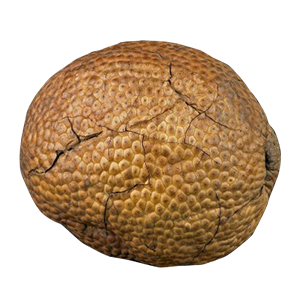 This lone breadfruit from an unspecified voyage of Captain Cook, now held at the British Museum, is deceptively simple at first glance. Labeled “Specimen of dried breadfruit,” this orb was much more than a specimen: at once a diplomatic tool, a cultural mediator, a food source for Tahitians, weary Europeans, and enslaved Africans alike, a culinary curiosity, a failed dream of Caribbean planters, a weapon, and an idea. Now, it is hollow and cracked, a mere outline of this past. But the inseparable histories of natural science, slavery, and consumption stick to its rind.
This lone breadfruit from an unspecified voyage of Captain Cook, now held at the British Museum, is deceptively simple at first glance. Labeled “Specimen of dried breadfruit,” this orb was much more than a specimen: at once a diplomatic tool, a cultural mediator, a food source for Tahitians, weary Europeans, and enslaved Africans alike, a culinary curiosity, a failed dream of Caribbean planters, a weapon, and an idea. Now, it is hollow and cracked, a mere outline of this past. But the inseparable histories of natural science, slavery, and consumption stick to its rind.
Breadfruit is a yellow-green fruit with starchy flesh and copious protein beneath its prickly exterior. When the voyagers on James Cook’s Endeavour expedition of 1768–1771 encountered the fruit throughout the Pacific, and especially as a cultural broker in Tahiti, a seed was planted in naturalist Sir Joseph Banks’s mind that would sprout into a scheme to cheaply provision enslaved Africans in the Caribbean in the 1780s and 1790s. After Banks became President of London’s Royal Society, and urged by the lobbying of West Indian planters, he embarked on a scheme to transplant breadfruit to the Caribbean as an economical means of feeding enslaved Africans and, by extension, increasing their output of commodities, chief among them food products like sugar. As the British Empire worked to provision its multi-hemispheric colonial holdings—all the more urgent due to the American Revolution’s disruption of trade—it looked to the science of natural history.
Banks’s breadfruit project resulted in one of the most famous mutinies of all time. William Bligh’s Bounty expedition was tasked by Banks and George III with transporting breadfruit from Tahiti to the West Indies. But on April 28, 1789, Bligh’s men threw the ship’s precious cargo of more than a thousand breadfruit seedlings overboard and sent Bligh and eighteen of his followers afloat on a small boat. A sketch showing the pots of breadfruit stored aboard the HMS Providence on Bligh’s second attempt at this assignment hauntingly resembles depictions of the Middle Passage. These plants, however, tenderly overseen by gardeners James Wiles and Christopher Smith and given water even when the crew went thirsty, almost certainly received better care than the African women, men, and children similarly packed into rows and fastened with shackles on slave ships bound for the New World. Scientific study and the slave trade were intimately bound in the early modern period.

When Bligh, who had also traveled on Cook’s third voyage, did eventually manage to transport breadfruit to islands like Jamaica and St. Vincent in the 1790s, enslaved people did not readily embrace it. In the words of Guyanese poet Maggie Harris:
You have writye me into Historye Booke!
I, Breadfruit, am bound for Stomach of black Men
First Jamaica Man not love Me
Because he not free
Black Men Lip seal like Liberty.
Harris’s poem proceeds to narrate how breadfruit has since become a staple of Caribbean cuisine. Even so, it remains continually contested in the region. In Jamaica Kincaid’s words, “Perhaps Antiguan children sense intuitively the part this food has played in the history of injustice and so they will not eat it. … In a place like Antigua the breadfruit is not a food, it is a weapon.”
A recent resurgence of interest in breadfruit has led several organizations to hail it as a panacea for world hunger without much reflection on its violent history—a history that spouted a similar blind optimism for the fruit to solve food shortages among marginalized groups in its day. Headlines range from “Breadfruit: The Next Superfood to End World Hunger?” to “Productive, Protein-Rich Breadfruit Could Help the World’s Hungry Tropics.” Meanwhile, the “Breadfruit History” page of the website of the Breadfruit Institute, based at the National Tropical Botanical Garden in Hawaiʻi, narrates Bligh’s mutiny without a single mention of slavery at the time of the publication of this exhibition.
The British Museum’s catalogue entry for the breadfruit describes it as “vegetal remains; food product (?)” in addition to a specimen. That question mark captures the indeterminacy of this material object: Curiosity or cuisine? Specimen or food? Provision or weapon? Salve or scourge? A triumph of European natural history and chattel slavery? Or a triumph of slave resistance and reappropriation?
Breadfruit figures in diasporic recipes to this day not despite the fruit’s tortured history, but in conversation with it. In her “Cousin Eddie’s Shark with Breadfruit Recipe,” Black feminist poet and playwright Ntozake Shange instructs: “You’ve peeled and seeded the breadfruit already. Don’t be afraid when it changes to a blood red color, that’s the mourning of our ancestors, hungry for us to live now.”
Image: “Specimen of Dried Breadfruit,” late eighteenth century, British Museum (Oc,TAH.71). © The Trustees of the British Museum.
 This article was written by Whitney Barlow Robles. For more information about her work and her other contributions to The Kitchen in the Cabinet click here.
This article was written by Whitney Barlow Robles. For more information about her work and her other contributions to The Kitchen in the Cabinet click here.
References
DeLoughrey, Elizabeth. “Globalizing the Routes of Breadfruit and Other Bounties.” Journal of Colonialism and Colonial History 8, no. 3 (Winter 2007).
Harris, Maggie. “I, Breadfruit.” Selected Poems. The Caribbean Press, 2011.
Kincaid, Jamaica. My Garden (Book). New York: Farrar, Straus and Giroux, 1999.
Morgan, Jennifer L. Reckoning with Slavery: Gender, Kinship, and Capitalism in the Early Black Atlantic. Durham, NC: Duke University Press, 2021. See especially Chapter 4, pages 141–169.
Shange, Ntozake. If I Can Cook / You Know God Can. Boston, MA: Beacon Press, 1998.
Sheller, Mimi. Consuming the Caribbean: From Arawaks to Zombies. London and New York: Routledge, 2003.